ACCT300 Auditing: Financial Statement Case Study Analysis
VerifiedAdded on 2023/06/08
|10
|2845
|63
Case Study
AI Summary
This assignment presents a comprehensive auditing case study focusing on EasyFit Pty Limited, a shoe manufacturer. The analysis begins with an examination of financial ratios, including current ratio, receivables turnover, inventory turnover, return on total assets, net profit margin, and gross profit margin, comparing EasyFit's performance to industry averages and prior year data. The analysis identifies potential audit risks associated with each ratio, such as liquidity concerns and inventory valuation. The case then explores audit procedures related to asset valuation, specifically the use of an expert under ASA 620 for land and building revaluation and the verification of machinery values in a computerized system. Furthermore, the assignment addresses the implications of a note receivable impairment, inventory discrepancies, a superannuation liability, and going concern uncertainties on the auditor's report, determining whether a qualified or unqualified opinion is appropriate. Finally, the case study considers the impact of subsequent events, including a debtor's insolvency and inventory damage due to flooding, on the financial statements and the required adjustments and disclosures.
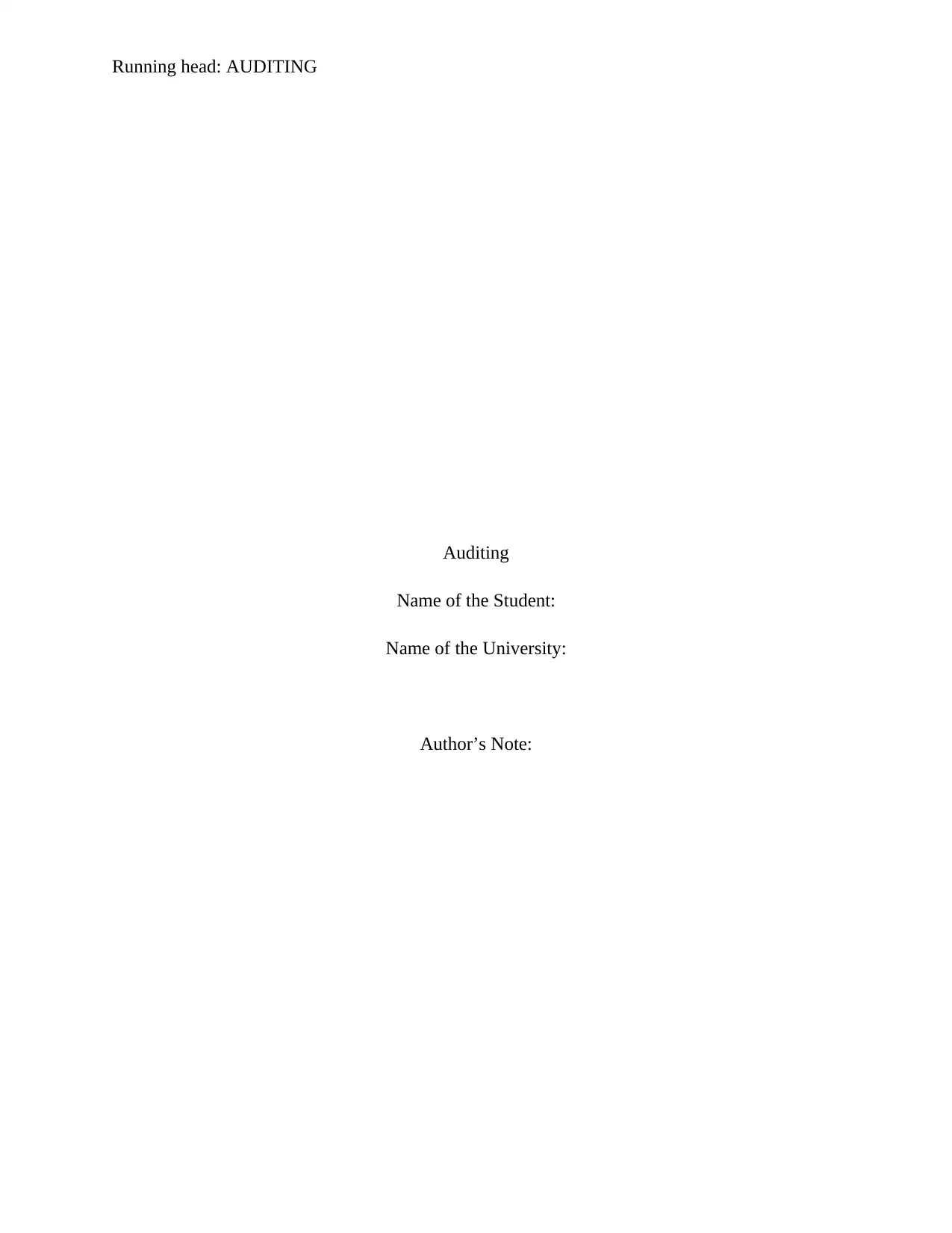
Running head: AUDITING
Auditing
Name of the Student:
Name of the University:
Author’s Note:
Auditing
Name of the Student:
Name of the University:
Author’s Note:
Paraphrase This Document
Need a fresh take? Get an instant paraphrase of this document with our AI Paraphraser
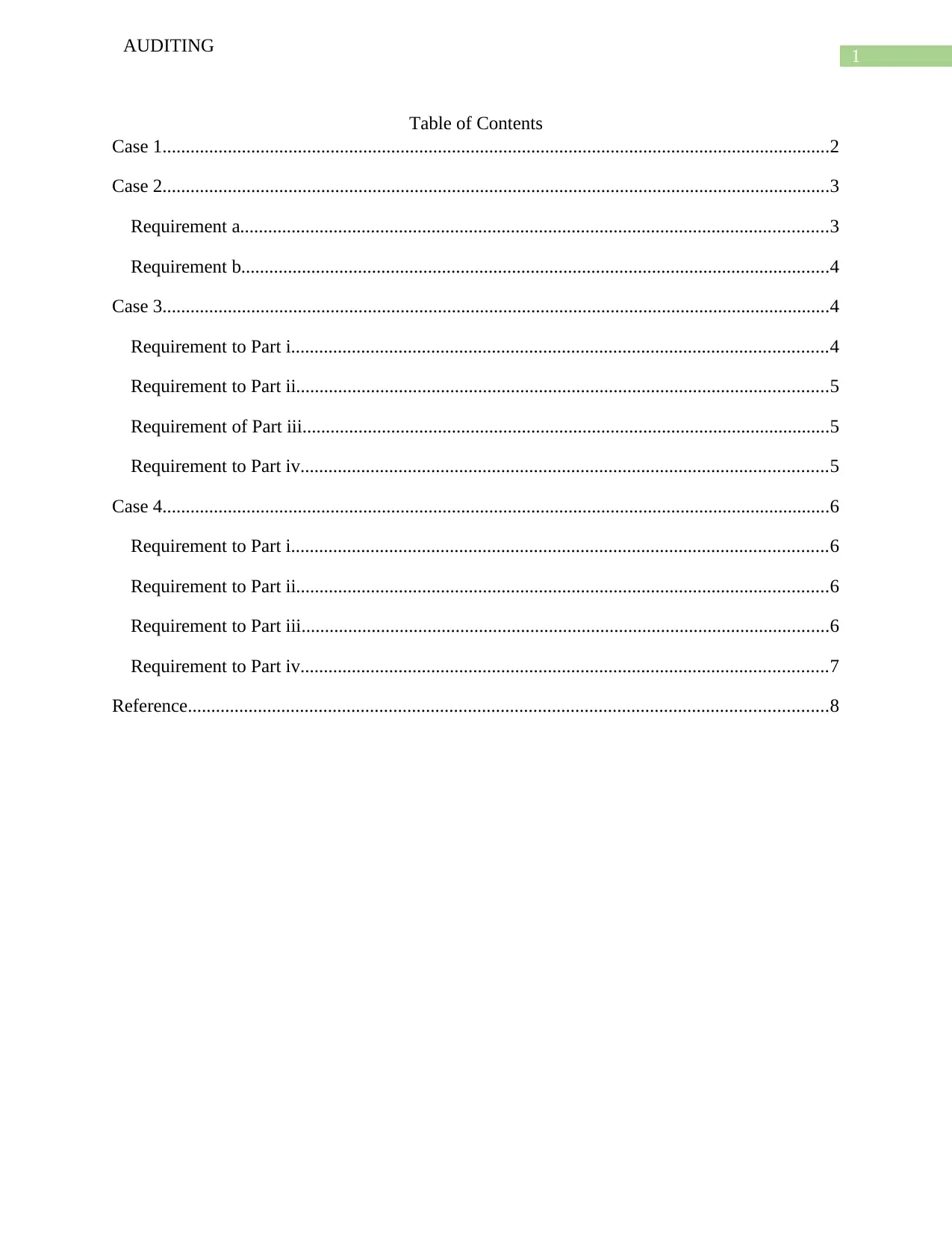
1
AUDITING
Table of Contents
Case 1...............................................................................................................................................2
Case 2...............................................................................................................................................3
Requirement a..............................................................................................................................3
Requirement b..............................................................................................................................4
Case 3...............................................................................................................................................4
Requirement to Part i...................................................................................................................4
Requirement to Part ii..................................................................................................................5
Requirement of Part iii.................................................................................................................5
Requirement to Part iv.................................................................................................................5
Case 4...............................................................................................................................................6
Requirement to Part i...................................................................................................................6
Requirement to Part ii..................................................................................................................6
Requirement to Part iii.................................................................................................................6
Requirement to Part iv.................................................................................................................7
Reference.........................................................................................................................................8
AUDITING
Table of Contents
Case 1...............................................................................................................................................2
Case 2...............................................................................................................................................3
Requirement a..............................................................................................................................3
Requirement b..............................................................................................................................4
Case 3...............................................................................................................................................4
Requirement to Part i...................................................................................................................4
Requirement to Part ii..................................................................................................................5
Requirement of Part iii.................................................................................................................5
Requirement to Part iv.................................................................................................................5
Case 4...............................................................................................................................................6
Requirement to Part i...................................................................................................................6
Requirement to Part ii..................................................................................................................6
Requirement to Part iii.................................................................................................................6
Requirement to Part iv.................................................................................................................7
Reference.........................................................................................................................................8
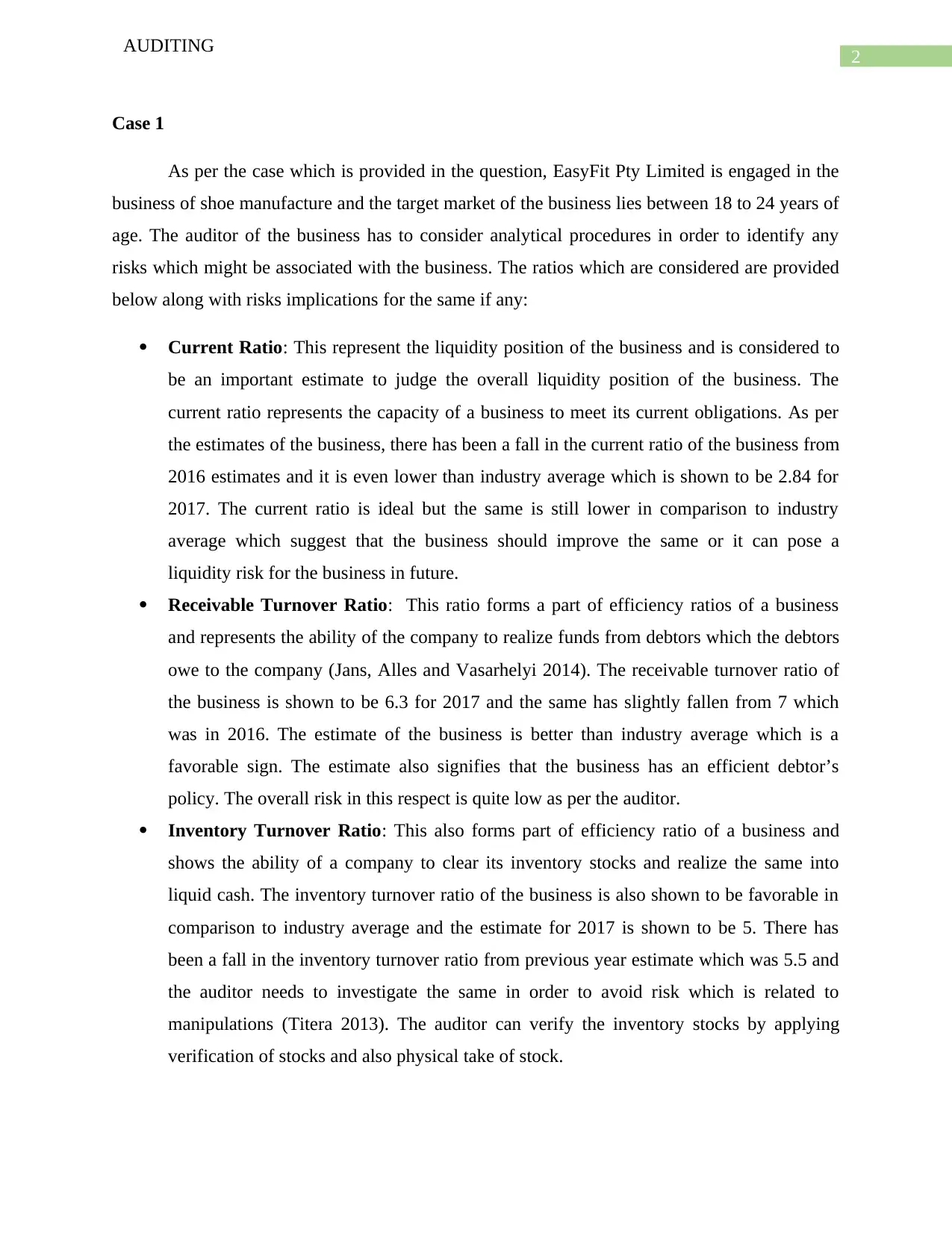
2
AUDITING
Case 1
As per the case which is provided in the question, EasyFit Pty Limited is engaged in the
business of shoe manufacture and the target market of the business lies between 18 to 24 years of
age. The auditor of the business has to consider analytical procedures in order to identify any
risks which might be associated with the business. The ratios which are considered are provided
below along with risks implications for the same if any:
Current Ratio: This represent the liquidity position of the business and is considered to
be an important estimate to judge the overall liquidity position of the business. The
current ratio represents the capacity of a business to meet its current obligations. As per
the estimates of the business, there has been a fall in the current ratio of the business from
2016 estimates and it is even lower than industry average which is shown to be 2.84 for
2017. The current ratio is ideal but the same is still lower in comparison to industry
average which suggest that the business should improve the same or it can pose a
liquidity risk for the business in future.
Receivable Turnover Ratio: This ratio forms a part of efficiency ratios of a business
and represents the ability of the company to realize funds from debtors which the debtors
owe to the company (Jans, Alles and Vasarhelyi 2014). The receivable turnover ratio of
the business is shown to be 6.3 for 2017 and the same has slightly fallen from 7 which
was in 2016. The estimate of the business is better than industry average which is a
favorable sign. The estimate also signifies that the business has an efficient debtor’s
policy. The overall risk in this respect is quite low as per the auditor.
Inventory Turnover Ratio: This also forms part of efficiency ratio of a business and
shows the ability of a company to clear its inventory stocks and realize the same into
liquid cash. The inventory turnover ratio of the business is also shown to be favorable in
comparison to industry average and the estimate for 2017 is shown to be 5. There has
been a fall in the inventory turnover ratio from previous year estimate which was 5.5 and
the auditor needs to investigate the same in order to avoid risk which is related to
manipulations (Titera 2013). The auditor can verify the inventory stocks by applying
verification of stocks and also physical take of stock.
AUDITING
Case 1
As per the case which is provided in the question, EasyFit Pty Limited is engaged in the
business of shoe manufacture and the target market of the business lies between 18 to 24 years of
age. The auditor of the business has to consider analytical procedures in order to identify any
risks which might be associated with the business. The ratios which are considered are provided
below along with risks implications for the same if any:
Current Ratio: This represent the liquidity position of the business and is considered to
be an important estimate to judge the overall liquidity position of the business. The
current ratio represents the capacity of a business to meet its current obligations. As per
the estimates of the business, there has been a fall in the current ratio of the business from
2016 estimates and it is even lower than industry average which is shown to be 2.84 for
2017. The current ratio is ideal but the same is still lower in comparison to industry
average which suggest that the business should improve the same or it can pose a
liquidity risk for the business in future.
Receivable Turnover Ratio: This ratio forms a part of efficiency ratios of a business
and represents the ability of the company to realize funds from debtors which the debtors
owe to the company (Jans, Alles and Vasarhelyi 2014). The receivable turnover ratio of
the business is shown to be 6.3 for 2017 and the same has slightly fallen from 7 which
was in 2016. The estimate of the business is better than industry average which is a
favorable sign. The estimate also signifies that the business has an efficient debtor’s
policy. The overall risk in this respect is quite low as per the auditor.
Inventory Turnover Ratio: This also forms part of efficiency ratio of a business and
shows the ability of a company to clear its inventory stocks and realize the same into
liquid cash. The inventory turnover ratio of the business is also shown to be favorable in
comparison to industry average and the estimate for 2017 is shown to be 5. There has
been a fall in the inventory turnover ratio from previous year estimate which was 5.5 and
the auditor needs to investigate the same in order to avoid risk which is related to
manipulations (Titera 2013). The auditor can verify the inventory stocks by applying
verification of stocks and also physical take of stock.
⊘ This is a preview!⊘
Do you want full access?
Subscribe today to unlock all pages.

Trusted by 1+ million students worldwide
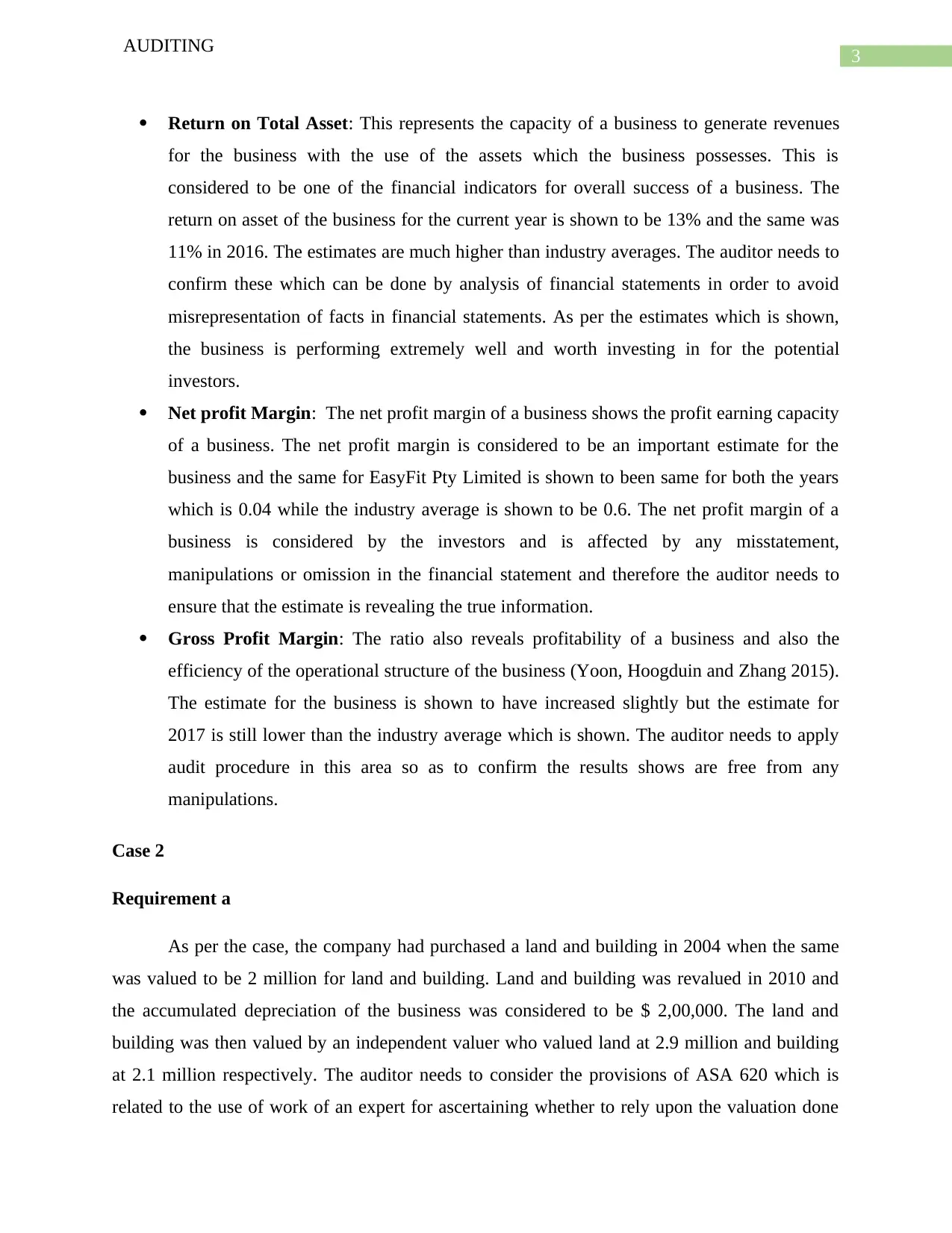
3
AUDITING
Return on Total Asset: This represents the capacity of a business to generate revenues
for the business with the use of the assets which the business possesses. This is
considered to be one of the financial indicators for overall success of a business. The
return on asset of the business for the current year is shown to be 13% and the same was
11% in 2016. The estimates are much higher than industry averages. The auditor needs to
confirm these which can be done by analysis of financial statements in order to avoid
misrepresentation of facts in financial statements. As per the estimates which is shown,
the business is performing extremely well and worth investing in for the potential
investors.
Net profit Margin: The net profit margin of a business shows the profit earning capacity
of a business. The net profit margin is considered to be an important estimate for the
business and the same for EasyFit Pty Limited is shown to been same for both the years
which is 0.04 while the industry average is shown to be 0.6. The net profit margin of a
business is considered by the investors and is affected by any misstatement,
manipulations or omission in the financial statement and therefore the auditor needs to
ensure that the estimate is revealing the true information.
Gross Profit Margin: The ratio also reveals profitability of a business and also the
efficiency of the operational structure of the business (Yoon, Hoogduin and Zhang 2015).
The estimate for the business is shown to have increased slightly but the estimate for
2017 is still lower than the industry average which is shown. The auditor needs to apply
audit procedure in this area so as to confirm the results shows are free from any
manipulations.
Case 2
Requirement a
As per the case, the company had purchased a land and building in 2004 when the same
was valued to be 2 million for land and building. Land and building was revalued in 2010 and
the accumulated depreciation of the business was considered to be $ 2,00,000. The land and
building was then valued by an independent valuer who valued land at 2.9 million and building
at 2.1 million respectively. The auditor needs to consider the provisions of ASA 620 which is
related to the use of work of an expert for ascertaining whether to rely upon the valuation done
AUDITING
Return on Total Asset: This represents the capacity of a business to generate revenues
for the business with the use of the assets which the business possesses. This is
considered to be one of the financial indicators for overall success of a business. The
return on asset of the business for the current year is shown to be 13% and the same was
11% in 2016. The estimates are much higher than industry averages. The auditor needs to
confirm these which can be done by analysis of financial statements in order to avoid
misrepresentation of facts in financial statements. As per the estimates which is shown,
the business is performing extremely well and worth investing in for the potential
investors.
Net profit Margin: The net profit margin of a business shows the profit earning capacity
of a business. The net profit margin is considered to be an important estimate for the
business and the same for EasyFit Pty Limited is shown to been same for both the years
which is 0.04 while the industry average is shown to be 0.6. The net profit margin of a
business is considered by the investors and is affected by any misstatement,
manipulations or omission in the financial statement and therefore the auditor needs to
ensure that the estimate is revealing the true information.
Gross Profit Margin: The ratio also reveals profitability of a business and also the
efficiency of the operational structure of the business (Yoon, Hoogduin and Zhang 2015).
The estimate for the business is shown to have increased slightly but the estimate for
2017 is still lower than the industry average which is shown. The auditor needs to apply
audit procedure in this area so as to confirm the results shows are free from any
manipulations.
Case 2
Requirement a
As per the case, the company had purchased a land and building in 2004 when the same
was valued to be 2 million for land and building. Land and building was revalued in 2010 and
the accumulated depreciation of the business was considered to be $ 2,00,000. The land and
building was then valued by an independent valuer who valued land at 2.9 million and building
at 2.1 million respectively. The auditor needs to consider the provisions of ASA 620 which is
related to the use of work of an expert for ascertaining whether to rely upon the valuation done
Paraphrase This Document
Need a fresh take? Get an instant paraphrase of this document with our AI Paraphraser
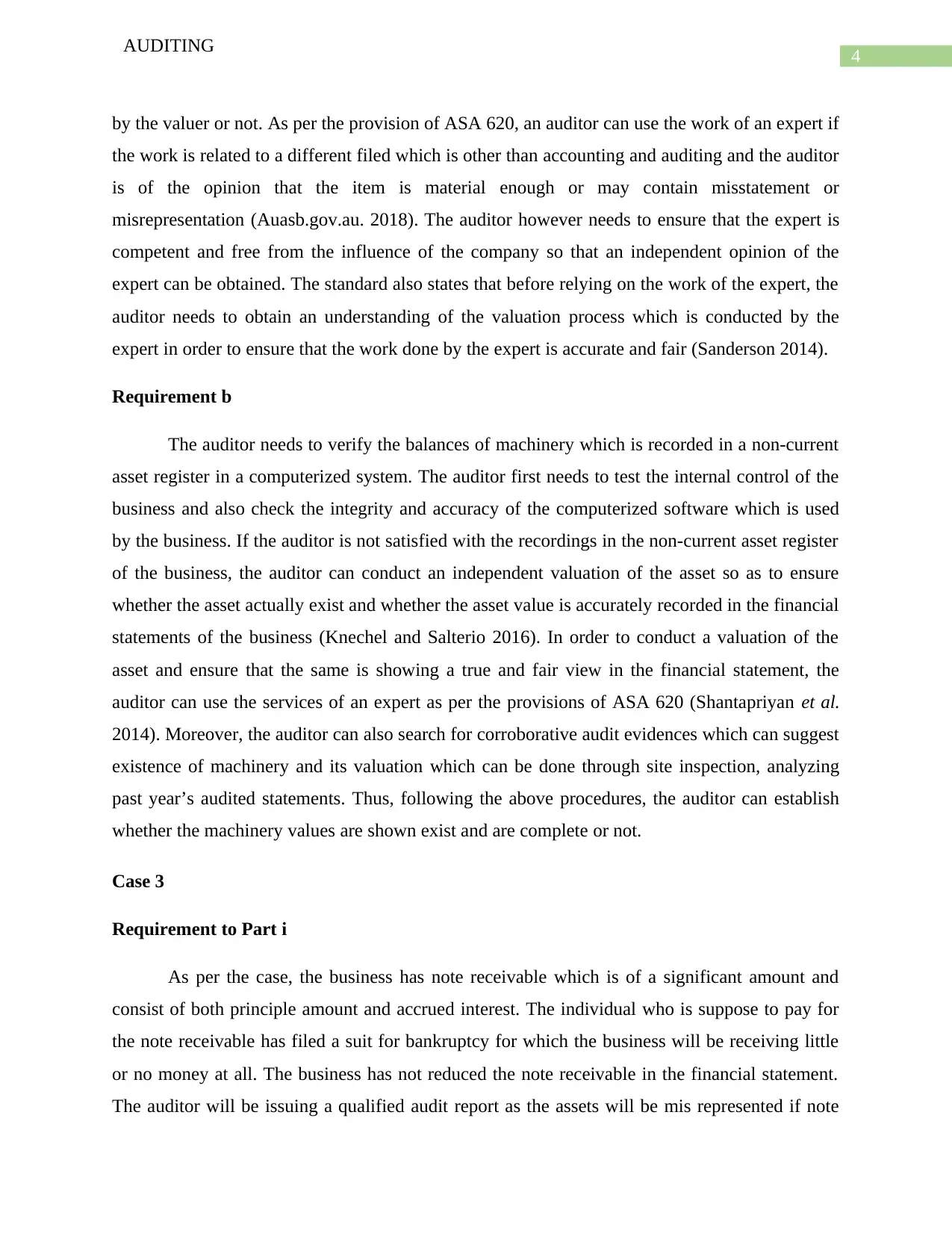
4
AUDITING
by the valuer or not. As per the provision of ASA 620, an auditor can use the work of an expert if
the work is related to a different filed which is other than accounting and auditing and the auditor
is of the opinion that the item is material enough or may contain misstatement or
misrepresentation (Auasb.gov.au. 2018). The auditor however needs to ensure that the expert is
competent and free from the influence of the company so that an independent opinion of the
expert can be obtained. The standard also states that before relying on the work of the expert, the
auditor needs to obtain an understanding of the valuation process which is conducted by the
expert in order to ensure that the work done by the expert is accurate and fair (Sanderson 2014).
Requirement b
The auditor needs to verify the balances of machinery which is recorded in a non-current
asset register in a computerized system. The auditor first needs to test the internal control of the
business and also check the integrity and accuracy of the computerized software which is used
by the business. If the auditor is not satisfied with the recordings in the non-current asset register
of the business, the auditor can conduct an independent valuation of the asset so as to ensure
whether the asset actually exist and whether the asset value is accurately recorded in the financial
statements of the business (Knechel and Salterio 2016). In order to conduct a valuation of the
asset and ensure that the same is showing a true and fair view in the financial statement, the
auditor can use the services of an expert as per the provisions of ASA 620 (Shantapriyan et al.
2014). Moreover, the auditor can also search for corroborative audit evidences which can suggest
existence of machinery and its valuation which can be done through site inspection, analyzing
past year’s audited statements. Thus, following the above procedures, the auditor can establish
whether the machinery values are shown exist and are complete or not.
Case 3
Requirement to Part i
As per the case, the business has note receivable which is of a significant amount and
consist of both principle amount and accrued interest. The individual who is suppose to pay for
the note receivable has filed a suit for bankruptcy for which the business will be receiving little
or no money at all. The business has not reduced the note receivable in the financial statement.
The auditor will be issuing a qualified audit report as the assets will be mis represented if note
AUDITING
by the valuer or not. As per the provision of ASA 620, an auditor can use the work of an expert if
the work is related to a different filed which is other than accounting and auditing and the auditor
is of the opinion that the item is material enough or may contain misstatement or
misrepresentation (Auasb.gov.au. 2018). The auditor however needs to ensure that the expert is
competent and free from the influence of the company so that an independent opinion of the
expert can be obtained. The standard also states that before relying on the work of the expert, the
auditor needs to obtain an understanding of the valuation process which is conducted by the
expert in order to ensure that the work done by the expert is accurate and fair (Sanderson 2014).
Requirement b
The auditor needs to verify the balances of machinery which is recorded in a non-current
asset register in a computerized system. The auditor first needs to test the internal control of the
business and also check the integrity and accuracy of the computerized software which is used
by the business. If the auditor is not satisfied with the recordings in the non-current asset register
of the business, the auditor can conduct an independent valuation of the asset so as to ensure
whether the asset actually exist and whether the asset value is accurately recorded in the financial
statements of the business (Knechel and Salterio 2016). In order to conduct a valuation of the
asset and ensure that the same is showing a true and fair view in the financial statement, the
auditor can use the services of an expert as per the provisions of ASA 620 (Shantapriyan et al.
2014). Moreover, the auditor can also search for corroborative audit evidences which can suggest
existence of machinery and its valuation which can be done through site inspection, analyzing
past year’s audited statements. Thus, following the above procedures, the auditor can establish
whether the machinery values are shown exist and are complete or not.
Case 3
Requirement to Part i
As per the case, the business has note receivable which is of a significant amount and
consist of both principle amount and accrued interest. The individual who is suppose to pay for
the note receivable has filed a suit for bankruptcy for which the business will be receiving little
or no money at all. The business has not reduced the note receivable in the financial statement.
The auditor will be issuing a qualified audit report as the assets will be mis represented if note
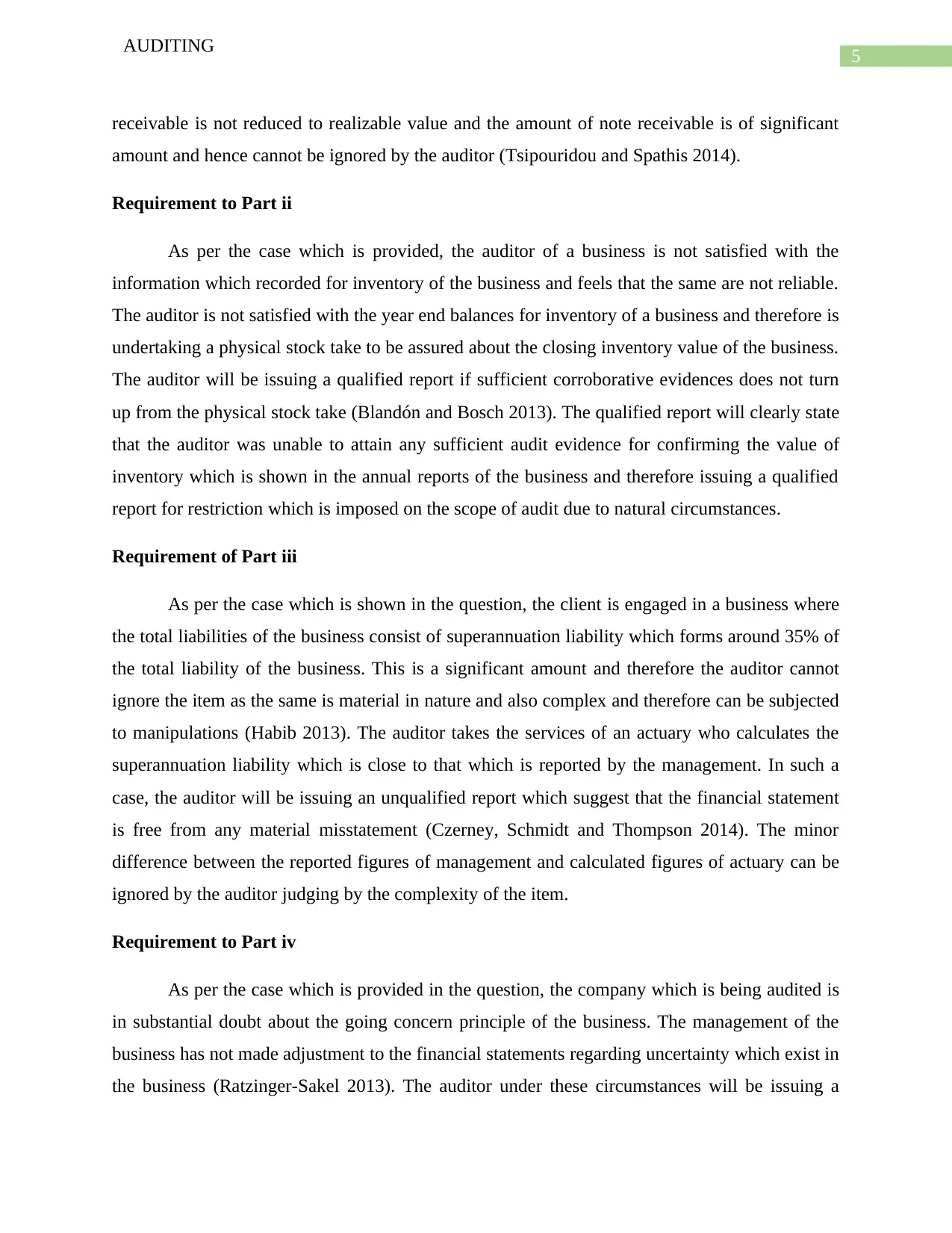
5
AUDITING
receivable is not reduced to realizable value and the amount of note receivable is of significant
amount and hence cannot be ignored by the auditor (Tsipouridou and Spathis 2014).
Requirement to Part ii
As per the case which is provided, the auditor of a business is not satisfied with the
information which recorded for inventory of the business and feels that the same are not reliable.
The auditor is not satisfied with the year end balances for inventory of a business and therefore is
undertaking a physical stock take to be assured about the closing inventory value of the business.
The auditor will be issuing a qualified report if sufficient corroborative evidences does not turn
up from the physical stock take (Blandón and Bosch 2013). The qualified report will clearly state
that the auditor was unable to attain any sufficient audit evidence for confirming the value of
inventory which is shown in the annual reports of the business and therefore issuing a qualified
report for restriction which is imposed on the scope of audit due to natural circumstances.
Requirement of Part iii
As per the case which is shown in the question, the client is engaged in a business where
the total liabilities of the business consist of superannuation liability which forms around 35% of
the total liability of the business. This is a significant amount and therefore the auditor cannot
ignore the item as the same is material in nature and also complex and therefore can be subjected
to manipulations (Habib 2013). The auditor takes the services of an actuary who calculates the
superannuation liability which is close to that which is reported by the management. In such a
case, the auditor will be issuing an unqualified report which suggest that the financial statement
is free from any material misstatement (Czerney, Schmidt and Thompson 2014). The minor
difference between the reported figures of management and calculated figures of actuary can be
ignored by the auditor judging by the complexity of the item.
Requirement to Part iv
As per the case which is provided in the question, the company which is being audited is
in substantial doubt about the going concern principle of the business. The management of the
business has not made adjustment to the financial statements regarding uncertainty which exist in
the business (Ratzinger-Sakel 2013). The auditor under these circumstances will be issuing a
AUDITING
receivable is not reduced to realizable value and the amount of note receivable is of significant
amount and hence cannot be ignored by the auditor (Tsipouridou and Spathis 2014).
Requirement to Part ii
As per the case which is provided, the auditor of a business is not satisfied with the
information which recorded for inventory of the business and feels that the same are not reliable.
The auditor is not satisfied with the year end balances for inventory of a business and therefore is
undertaking a physical stock take to be assured about the closing inventory value of the business.
The auditor will be issuing a qualified report if sufficient corroborative evidences does not turn
up from the physical stock take (Blandón and Bosch 2013). The qualified report will clearly state
that the auditor was unable to attain any sufficient audit evidence for confirming the value of
inventory which is shown in the annual reports of the business and therefore issuing a qualified
report for restriction which is imposed on the scope of audit due to natural circumstances.
Requirement of Part iii
As per the case which is shown in the question, the client is engaged in a business where
the total liabilities of the business consist of superannuation liability which forms around 35% of
the total liability of the business. This is a significant amount and therefore the auditor cannot
ignore the item as the same is material in nature and also complex and therefore can be subjected
to manipulations (Habib 2013). The auditor takes the services of an actuary who calculates the
superannuation liability which is close to that which is reported by the management. In such a
case, the auditor will be issuing an unqualified report which suggest that the financial statement
is free from any material misstatement (Czerney, Schmidt and Thompson 2014). The minor
difference between the reported figures of management and calculated figures of actuary can be
ignored by the auditor judging by the complexity of the item.
Requirement to Part iv
As per the case which is provided in the question, the company which is being audited is
in substantial doubt about the going concern principle of the business. The management of the
business has not made adjustment to the financial statements regarding uncertainty which exist in
the business (Ratzinger-Sakel 2013). The auditor under these circumstances will be issuing a
⊘ This is a preview!⊘
Do you want full access?
Subscribe today to unlock all pages.

Trusted by 1+ million students worldwide
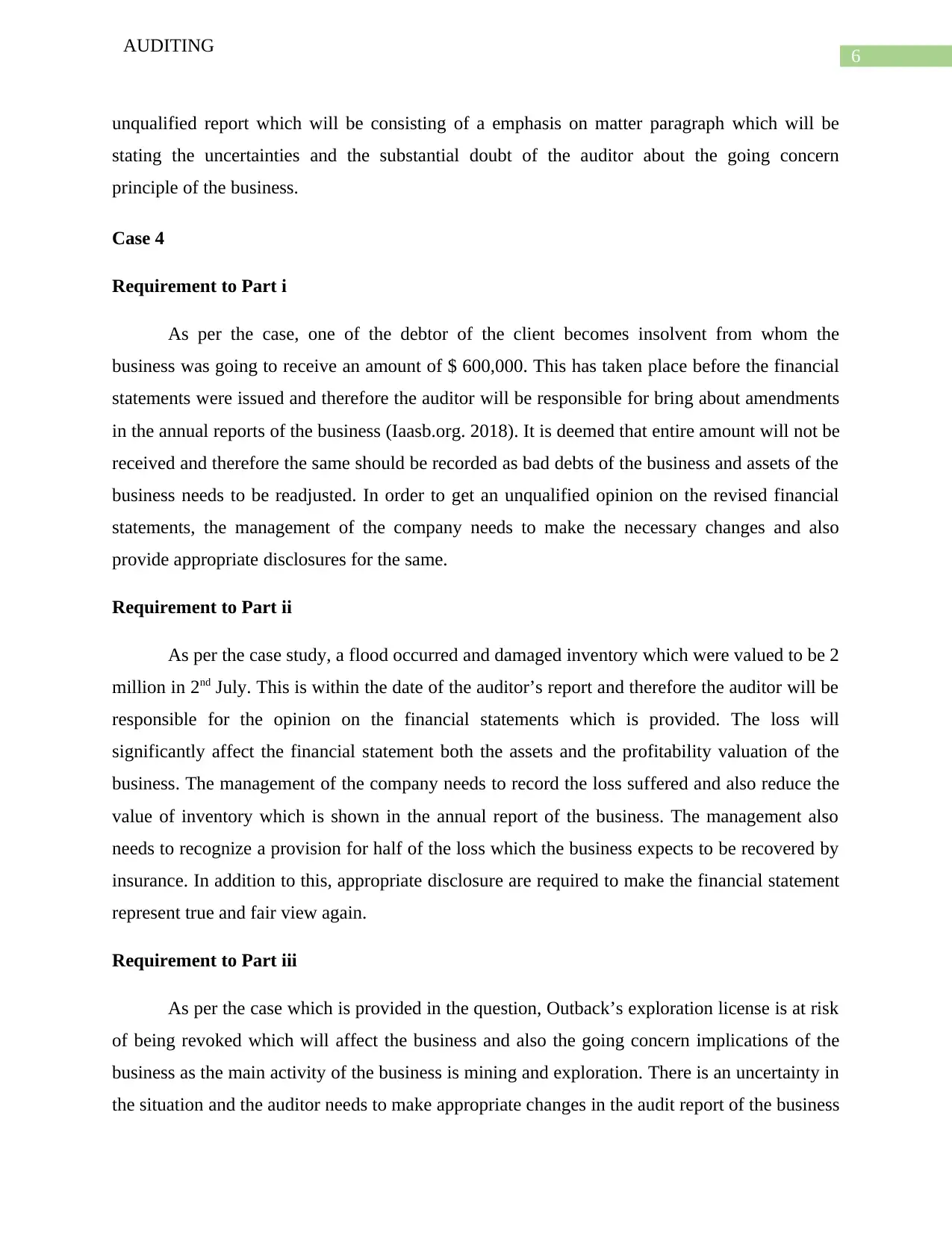
6
AUDITING
unqualified report which will be consisting of a emphasis on matter paragraph which will be
stating the uncertainties and the substantial doubt of the auditor about the going concern
principle of the business.
Case 4
Requirement to Part i
As per the case, one of the debtor of the client becomes insolvent from whom the
business was going to receive an amount of $ 600,000. This has taken place before the financial
statements were issued and therefore the auditor will be responsible for bring about amendments
in the annual reports of the business (Iaasb.org. 2018). It is deemed that entire amount will not be
received and therefore the same should be recorded as bad debts of the business and assets of the
business needs to be readjusted. In order to get an unqualified opinion on the revised financial
statements, the management of the company needs to make the necessary changes and also
provide appropriate disclosures for the same.
Requirement to Part ii
As per the case study, a flood occurred and damaged inventory which were valued to be 2
million in 2nd July. This is within the date of the auditor’s report and therefore the auditor will be
responsible for the opinion on the financial statements which is provided. The loss will
significantly affect the financial statement both the assets and the profitability valuation of the
business. The management of the company needs to record the loss suffered and also reduce the
value of inventory which is shown in the annual report of the business. The management also
needs to recognize a provision for half of the loss which the business expects to be recovered by
insurance. In addition to this, appropriate disclosure are required to make the financial statement
represent true and fair view again.
Requirement to Part iii
As per the case which is provided in the question, Outback’s exploration license is at risk
of being revoked which will affect the business and also the going concern implications of the
business as the main activity of the business is mining and exploration. There is an uncertainty in
the situation and the auditor needs to make appropriate changes in the audit report of the business
AUDITING
unqualified report which will be consisting of a emphasis on matter paragraph which will be
stating the uncertainties and the substantial doubt of the auditor about the going concern
principle of the business.
Case 4
Requirement to Part i
As per the case, one of the debtor of the client becomes insolvent from whom the
business was going to receive an amount of $ 600,000. This has taken place before the financial
statements were issued and therefore the auditor will be responsible for bring about amendments
in the annual reports of the business (Iaasb.org. 2018). It is deemed that entire amount will not be
received and therefore the same should be recorded as bad debts of the business and assets of the
business needs to be readjusted. In order to get an unqualified opinion on the revised financial
statements, the management of the company needs to make the necessary changes and also
provide appropriate disclosures for the same.
Requirement to Part ii
As per the case study, a flood occurred and damaged inventory which were valued to be 2
million in 2nd July. This is within the date of the auditor’s report and therefore the auditor will be
responsible for the opinion on the financial statements which is provided. The loss will
significantly affect the financial statement both the assets and the profitability valuation of the
business. The management of the company needs to record the loss suffered and also reduce the
value of inventory which is shown in the annual report of the business. The management also
needs to recognize a provision for half of the loss which the business expects to be recovered by
insurance. In addition to this, appropriate disclosure are required to make the financial statement
represent true and fair view again.
Requirement to Part iii
As per the case which is provided in the question, Outback’s exploration license is at risk
of being revoked which will affect the business and also the going concern implications of the
business as the main activity of the business is mining and exploration. There is an uncertainty in
the situation and the auditor needs to make appropriate changes in the audit report of the business
Paraphrase This Document
Need a fresh take? Get an instant paraphrase of this document with our AI Paraphraser
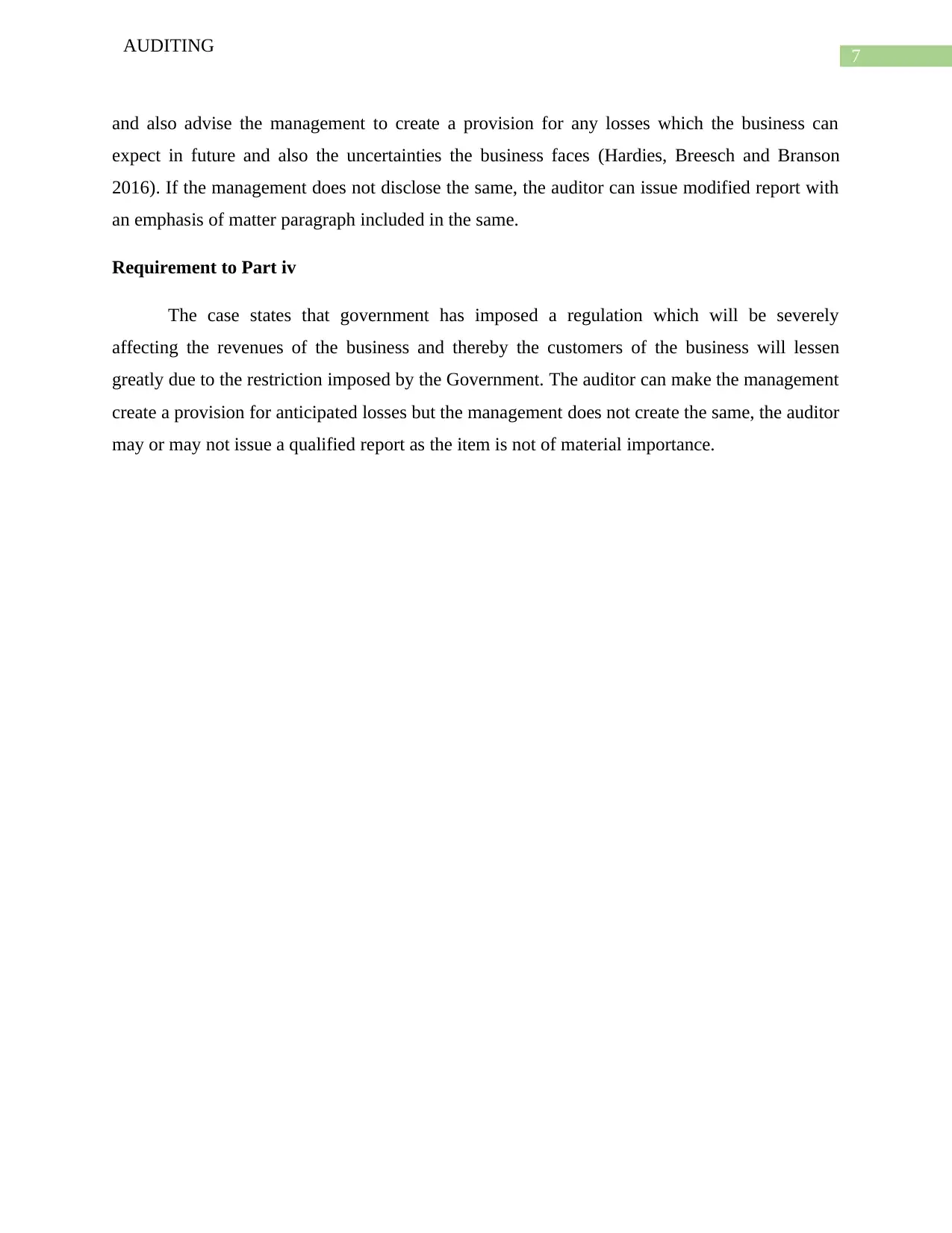
7
AUDITING
and also advise the management to create a provision for any losses which the business can
expect in future and also the uncertainties the business faces (Hardies, Breesch and Branson
2016). If the management does not disclose the same, the auditor can issue modified report with
an emphasis of matter paragraph included in the same.
Requirement to Part iv
The case states that government has imposed a regulation which will be severely
affecting the revenues of the business and thereby the customers of the business will lessen
greatly due to the restriction imposed by the Government. The auditor can make the management
create a provision for anticipated losses but the management does not create the same, the auditor
may or may not issue a qualified report as the item is not of material importance.
AUDITING
and also advise the management to create a provision for any losses which the business can
expect in future and also the uncertainties the business faces (Hardies, Breesch and Branson
2016). If the management does not disclose the same, the auditor can issue modified report with
an emphasis of matter paragraph included in the same.
Requirement to Part iv
The case states that government has imposed a regulation which will be severely
affecting the revenues of the business and thereby the customers of the business will lessen
greatly due to the restriction imposed by the Government. The auditor can make the management
create a provision for anticipated losses but the management does not create the same, the auditor
may or may not issue a qualified report as the item is not of material importance.
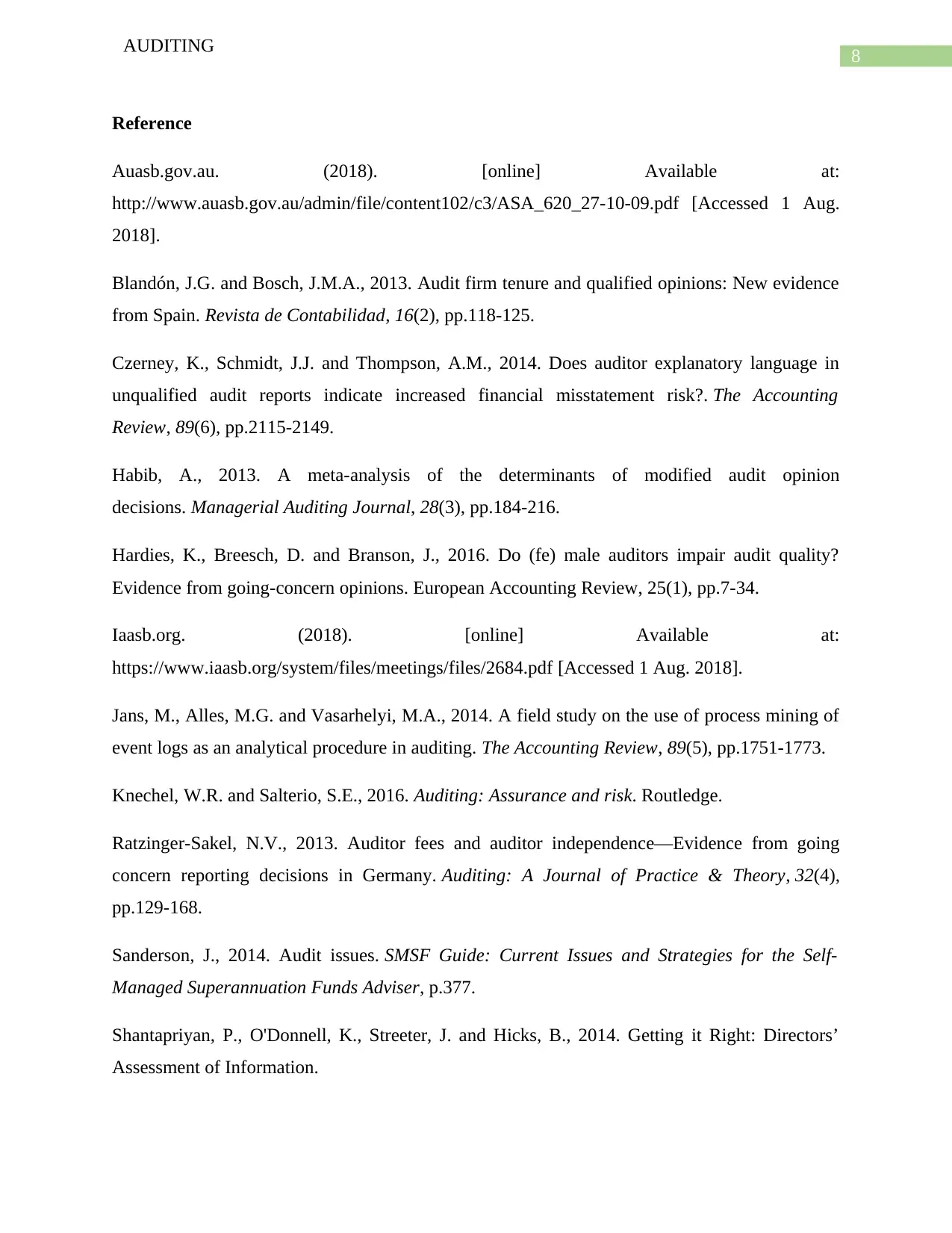
8
AUDITING
Reference
Auasb.gov.au. (2018). [online] Available at:
http://www.auasb.gov.au/admin/file/content102/c3/ASA_620_27-10-09.pdf [Accessed 1 Aug.
2018].
Blandón, J.G. and Bosch, J.M.A., 2013. Audit firm tenure and qualified opinions: New evidence
from Spain. Revista de Contabilidad, 16(2), pp.118-125.
Czerney, K., Schmidt, J.J. and Thompson, A.M., 2014. Does auditor explanatory language in
unqualified audit reports indicate increased financial misstatement risk?. The Accounting
Review, 89(6), pp.2115-2149.
Habib, A., 2013. A meta-analysis of the determinants of modified audit opinion
decisions. Managerial Auditing Journal, 28(3), pp.184-216.
Hardies, K., Breesch, D. and Branson, J., 2016. Do (fe) male auditors impair audit quality?
Evidence from going-concern opinions. European Accounting Review, 25(1), pp.7-34.
Iaasb.org. (2018). [online] Available at:
https://www.iaasb.org/system/files/meetings/files/2684.pdf [Accessed 1 Aug. 2018].
Jans, M., Alles, M.G. and Vasarhelyi, M.A., 2014. A field study on the use of process mining of
event logs as an analytical procedure in auditing. The Accounting Review, 89(5), pp.1751-1773.
Knechel, W.R. and Salterio, S.E., 2016. Auditing: Assurance and risk. Routledge.
Ratzinger-Sakel, N.V., 2013. Auditor fees and auditor independence—Evidence from going
concern reporting decisions in Germany. Auditing: A Journal of Practice & Theory, 32(4),
pp.129-168.
Sanderson, J., 2014. Audit issues. SMSF Guide: Current Issues and Strategies for the Self-
Managed Superannuation Funds Adviser, p.377.
Shantapriyan, P., O'Donnell, K., Streeter, J. and Hicks, B., 2014. Getting it Right: Directors’
Assessment of Information.
AUDITING
Reference
Auasb.gov.au. (2018). [online] Available at:
http://www.auasb.gov.au/admin/file/content102/c3/ASA_620_27-10-09.pdf [Accessed 1 Aug.
2018].
Blandón, J.G. and Bosch, J.M.A., 2013. Audit firm tenure and qualified opinions: New evidence
from Spain. Revista de Contabilidad, 16(2), pp.118-125.
Czerney, K., Schmidt, J.J. and Thompson, A.M., 2014. Does auditor explanatory language in
unqualified audit reports indicate increased financial misstatement risk?. The Accounting
Review, 89(6), pp.2115-2149.
Habib, A., 2013. A meta-analysis of the determinants of modified audit opinion
decisions. Managerial Auditing Journal, 28(3), pp.184-216.
Hardies, K., Breesch, D. and Branson, J., 2016. Do (fe) male auditors impair audit quality?
Evidence from going-concern opinions. European Accounting Review, 25(1), pp.7-34.
Iaasb.org. (2018). [online] Available at:
https://www.iaasb.org/system/files/meetings/files/2684.pdf [Accessed 1 Aug. 2018].
Jans, M., Alles, M.G. and Vasarhelyi, M.A., 2014. A field study on the use of process mining of
event logs as an analytical procedure in auditing. The Accounting Review, 89(5), pp.1751-1773.
Knechel, W.R. and Salterio, S.E., 2016. Auditing: Assurance and risk. Routledge.
Ratzinger-Sakel, N.V., 2013. Auditor fees and auditor independence—Evidence from going
concern reporting decisions in Germany. Auditing: A Journal of Practice & Theory, 32(4),
pp.129-168.
Sanderson, J., 2014. Audit issues. SMSF Guide: Current Issues and Strategies for the Self-
Managed Superannuation Funds Adviser, p.377.
Shantapriyan, P., O'Donnell, K., Streeter, J. and Hicks, B., 2014. Getting it Right: Directors’
Assessment of Information.
⊘ This is a preview!⊘
Do you want full access?
Subscribe today to unlock all pages.

Trusted by 1+ million students worldwide
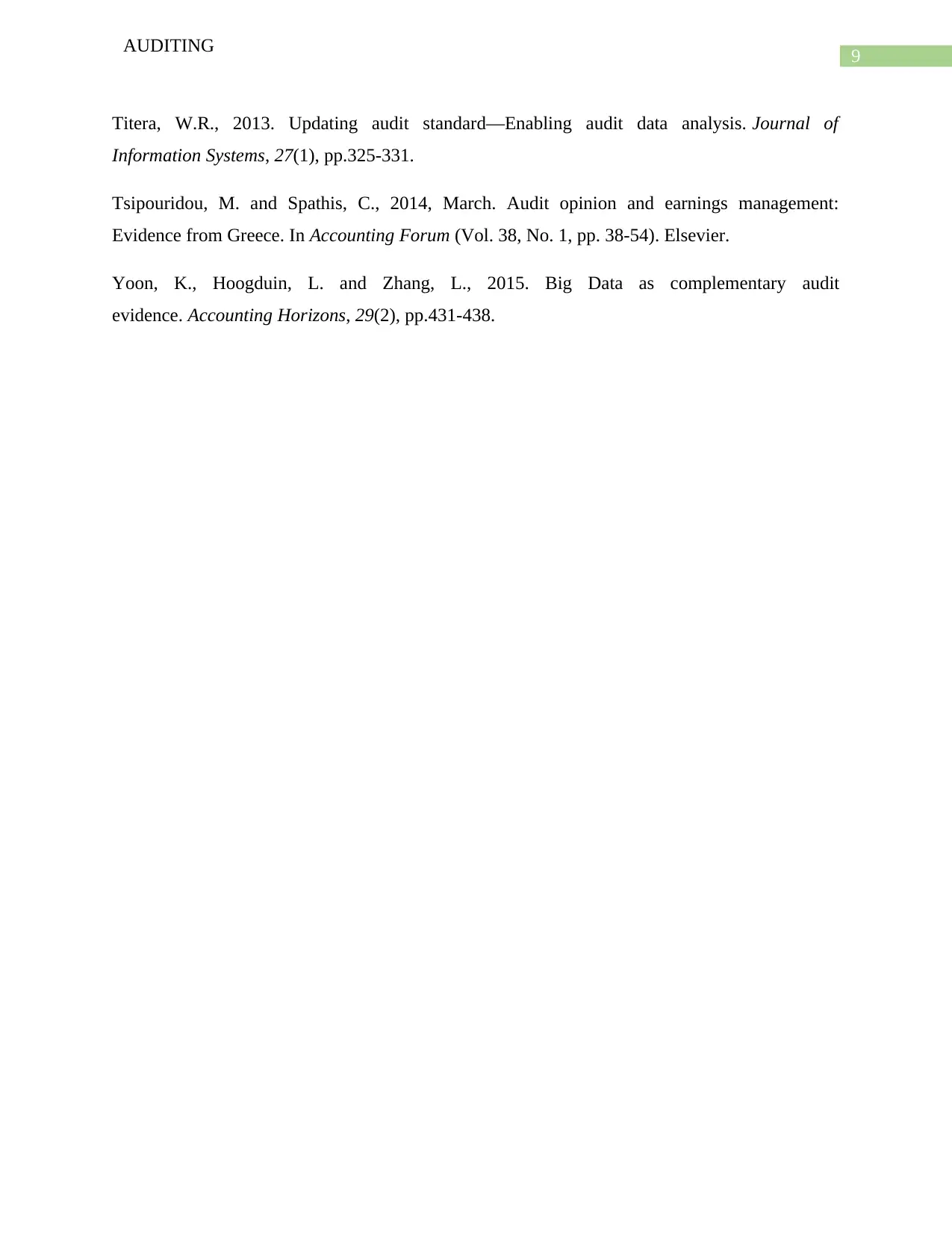
9
AUDITING
Titera, W.R., 2013. Updating audit standard—Enabling audit data analysis. Journal of
Information Systems, 27(1), pp.325-331.
Tsipouridou, M. and Spathis, C., 2014, March. Audit opinion and earnings management:
Evidence from Greece. In Accounting Forum (Vol. 38, No. 1, pp. 38-54). Elsevier.
Yoon, K., Hoogduin, L. and Zhang, L., 2015. Big Data as complementary audit
evidence. Accounting Horizons, 29(2), pp.431-438.
AUDITING
Titera, W.R., 2013. Updating audit standard—Enabling audit data analysis. Journal of
Information Systems, 27(1), pp.325-331.
Tsipouridou, M. and Spathis, C., 2014, March. Audit opinion and earnings management:
Evidence from Greece. In Accounting Forum (Vol. 38, No. 1, pp. 38-54). Elsevier.
Yoon, K., Hoogduin, L. and Zhang, L., 2015. Big Data as complementary audit
evidence. Accounting Horizons, 29(2), pp.431-438.
1 out of 10
Related Documents
Your All-in-One AI-Powered Toolkit for Academic Success.
+13062052269
info@desklib.com
Available 24*7 on WhatsApp / Email
![[object Object]](/_next/static/media/star-bottom.7253800d.svg)
Unlock your academic potential
Copyright © 2020–2025 A2Z Services. All Rights Reserved. Developed and managed by ZUCOL.



